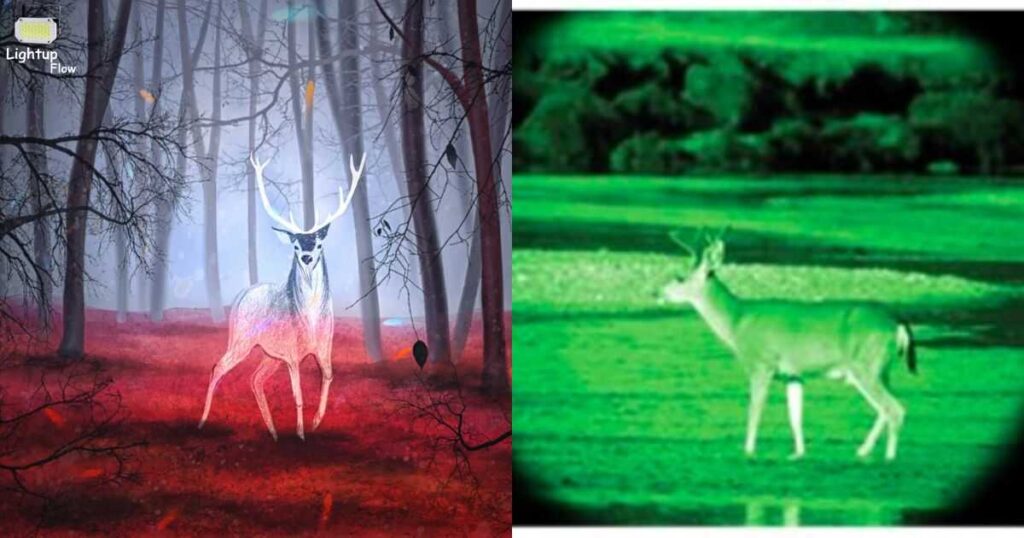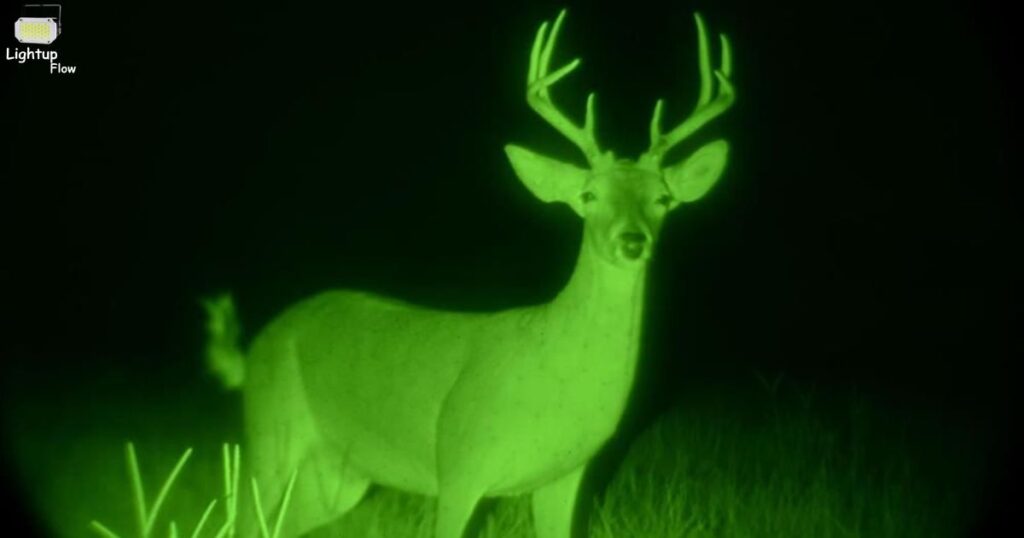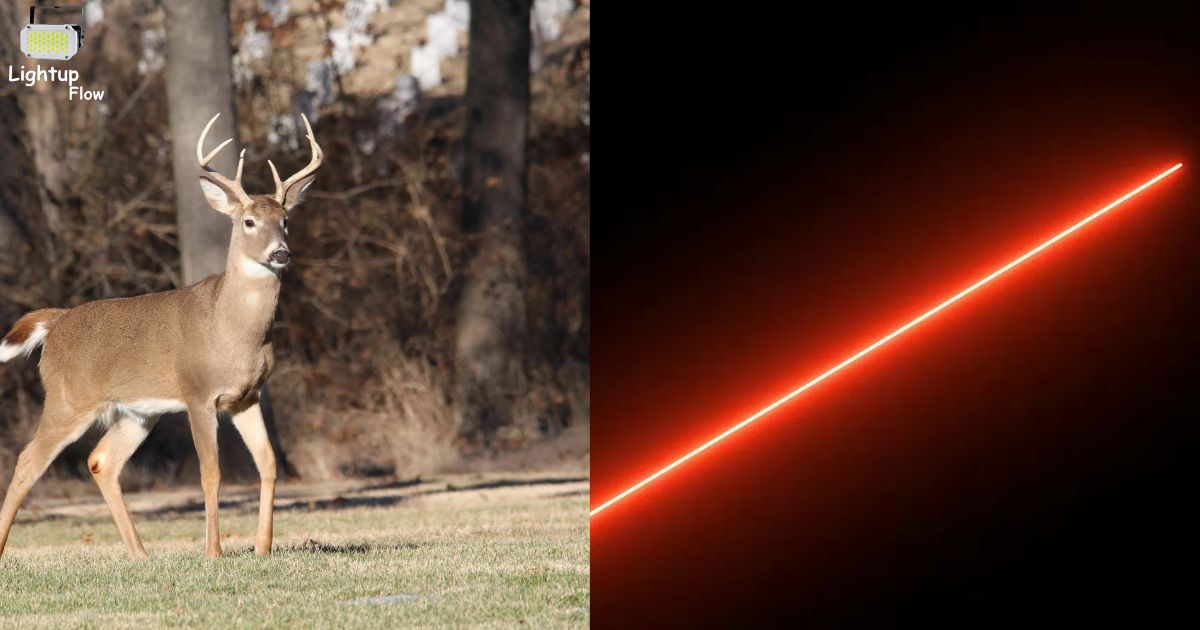Deer are animals known for their keen eyesight, adapted for detecting movement and differentiating colors. Their vision includes a range of hues, but their perception of specific colors, especially red, is debated among researchers.
The question of whether deer can see red LED lights intrigues both wildlife enthusiasts and hunters seeking effective strategies for minimizing detection during hunting seasons.
Studies suggest that deer likely perceive red light differently than humans. While they might detect it, their ability to distinguish it from other colors or perceive it as alarming remains uncertain, making red LED lights a potential tool for minimizing disturbance in deer-populated areas.
Overview Of A Deer See Red LED Lights
Deer are primarily sensitive to blue and green wavelengths, making red light less visible to them. While they can perceive red light, it appears dimmer and less conspicuous compared to other colors. LED lights emit minimal heat and produce low-intensity red light, which may not significantly alarm deer. Wondering for more information on this topic Take Off Led Lights Without Taking Off Paints
It’s advisable to use caution as any sudden or unusual light sources can potentially startle wildlife. Researchers continue to explore deer vision to better understand their perception of different light spectrums for safer interactions in their habitats.
Key Takeaways
Red Leds Are Visible To Deer: Scientific studies suggest that deer can see certain wavelengths of red light, including those emitted by red LEDs.
Attracted Or Deterred: While some hunters use red LED lights believing deer can’t see them, there’s debate about whether these lights attract or repel deer, as their reaction might vary based on context and other environmental factors.
Limited Visibility: Deer have limited color vision compared to humans, but they’re sensitive to shorter wavelengths in the blue and green spectrum, making red lights detectable but possibly less conspicuous.
Consider Camouflage: Using red LEDs in hunting scenarios might require additional camouflage or cover to offset any potential visibility to deer, as they’re highly perceptive to movement and unusual objects in their environment.
Varied Reactions: Deer behavior in response to red LED lights isn’t universally consistent, so while they might notice these lights, their reaction could differ based on individual factors, making it a less reliable strategy for hunting or deterring deer.
Step By Step Guide To Deer See Red Led Lights
Understand deer vision: Deer have dichromatic vision, limited to blue and green wavelengths. They lack the receptors to perceive red light.
Experiment with caution: Use red LED lights while observing deer behavior. They’re less likely to react strongly to red lights due to their inability to fully see this color.
Remember other factors: While red lights may be less visible to deer, factors like movement and scent can still alert them. Use red lights cautiously and consider other ways to minimize disturbance when observing or approaching deer.
Can Deer See Red Or Green Light

Deer possess dichromatic vision, primarily perceiving blues and greens. Their limited color perception makes it unlikely for them to discern red or green lights distinctly. Instead, they rely on contrasting brightness levels and movement.
The wavelengths of red and green light may appear as shades of gray to them. Their keen sensitivity to motion aids in detecting predators or potential threats, allowing them to navigate the world using a blend of visual cues beyond just color.
Led Lights Colors Can Deer See
Deer perceive LED lights differently than humans. While deer can see blue and green hues more prominently, they struggle with distinguishing reds and oranges. LED lights emitting blue or green wavelengths might catch their attention more than warmer tones.
Considering their visual sensitivity, using specific LED colors can help minimize disturbance to deer habitats, ensuring a more harmonious coexistence between human activities and the natural environment.
Do Deer Detect Red Led Lights
Deer possess keen senses, but their detection of red LED lights remains inconclusive. While some studies hint at their ability to notice longer wavelengths, conclusive evidence on red LEDs’ impact is scarce. These creatures rely more on motion, scent, and silhouette recognition, making the significance of red light detection unclear.
Ongoing research aims to unravel the nuances of deer perception, shedding light on their responses to various wavelengths and aiding wildlife management strategies. Thus, the mystery of whether deer detect red LED lights persists, inviting further scientific exploration into their visual perception.
Understanding Deer And Red Leds

Understanding deer behavior in relation to red LEDs unveils a captivating intersection of nature and technology. Red LEDs, often associated with minimizing disturbance in wildlife settings, seem to evoke a unique response in deer. Studies suggest that these LEDs might have a calming effect, reducing stress and promoting a sense of security among deer populations.
Observations reveal their intriguing inclination to remain undisturbed and more at ease under the subtle glow of red LEDs, illuminating the potential for innovative conservation strategies and harmonious coexistence between technology and wildlife in their natural habitats.
Deer See Red Light Vs Green Light For Night Hunting
In the velvet quiet of moonlit woods, deer possess an uncanny vision, a nocturnal prowess attuned to hues of the night. To them, the world painted in shades of red beckons safety, a guardian against human eyes, while the emerald glow of green signals an eerie intrusion, an unwelcome intrusion in their nocturnal domain.
As the night veils the world in mystique, these creatures navigate the shadows, their perception an enigma to those who seek them. Their eyes, adept in discerning the spectral nuances, decode the signals of danger and calm, dancing between the crimson and jade luminance, a secret language whispered in the silent symphony of the night.
The Benefits Of Deer See Red Light
Harnessing the power of red light for deer vision unveils an array of benefits. This spectrum’s gentle hue minimizes disturbance to their nocturnal activities, allowing natural behaviors to flourish undisturbed. It aids in reducing stress levels, promoting a tranquil environment crucial for their well-being.
The utilization of red light proves instrumental in enhancing their vision without compromising their adaptability to darkness. It serves as an effective means to observe deer behavior, fostering a deeper understanding of their habits. Integrating red light benefits deer by preserving their natural rhythms while facilitating valuable research and conservation efforts.
Can Deer See Green Light At Night

Deer possess an acute sensitivity to light, especially in the blue spectrum, granting them exceptional vision in low-light conditions. While their eyes contain more rod cells than cones, enhancing their ability to detect movement in dim settings, they struggle to discern specific colors such as green at night.
Greenlight, while visible to deer, appears dimmer and less distinct, affecting their perception compared to other hues. In nocturnal settings, deer rely more on their motion detection and superior night vision rather than distinguishing colors like green in the darkened expanse, allowing them to navigate their environment with remarkable adaptability.
Conclusion
Deer See Red LED Lights differently than humans, likely appearing as a dim hue due to their limited red color sensitivity. Research suggests deer are more attuned to blue and green wavelengths.
While red lights might not startle them as much, caution is still advised when using them for hunting or wildlife observation. Understanding deer vision aids in developing more effective strategies for minimizing disturbance and ensuring their safety in shared environments.








